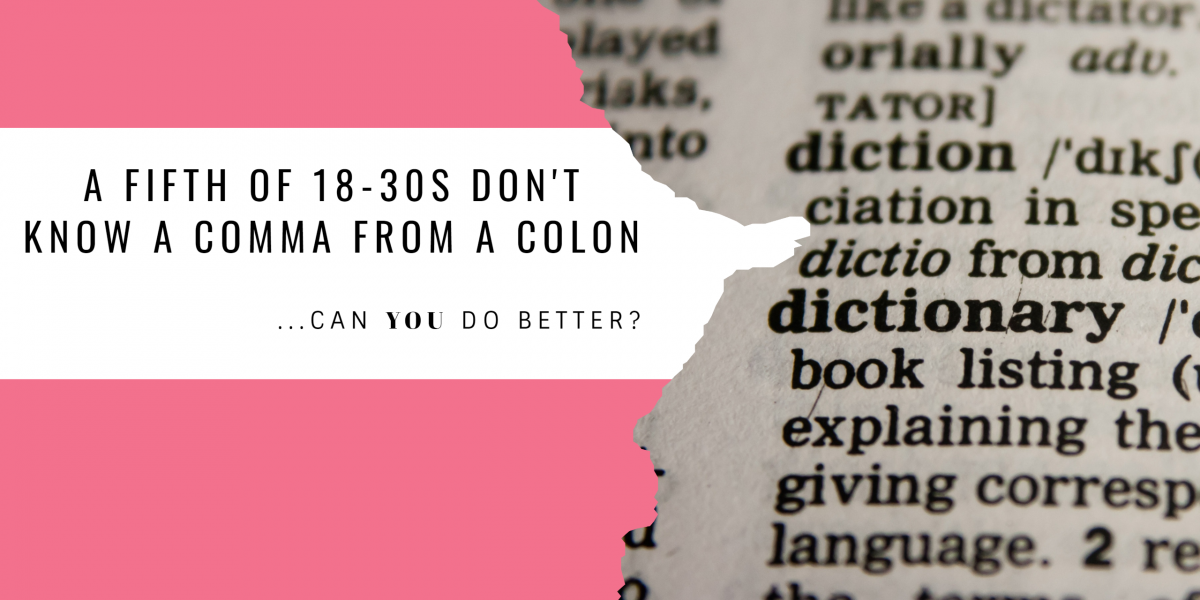
Take the Test Yourself
The words and punctuation marks that we tested our respondents with are listed below. Why not test yourself and see if you fare any better? The answers are at the foot of the page. Can you explain the true meaning of:
A metaphor
Personification
Alliteration
Onomatopoeia
Hyperbole
An oxymoron
Irony
A euphemism
Symbolism
An allegory
An analogy
A paradox
Synecdoche
Connotation
And what about these common punctuation marks (seen below in brackets). Do you know what each is and what it’s used for? Give yourself a mark for knowing a mark’s name and another if you know when or where to use it.
(.)
(,)
(?)
(!)
(;)
(:)
(‘)
(-)
(” ” or ‘ ‘)
(…)
(—)
([ ] or { })
( )
(&)
(/)
Answers
Metaphor: A metaphor is a direct comparison between two unlike things, stating that one is the other. For example, “Her smile was a ray of sunshine.”
Personification: Personification involves giving human characteristics to non-human entities or objects. For instance, “The wind whispered through the trees.”
Alliteration: Alliteration is the repetition of the same initial sound in a series of words or phrases, often for poetic or rhetorical effect. “Peter Piper picked a peck of pickled peppers” is a famous example.
Onomatopoeia: Onomatopoeia refers to words that imitate the sounds they describe. Examples include “buzz,” “moo,” and “bang.”
Hyperbole: Hyperbole is an exaggerated statement or claim that is not meant to be taken literally. For example, “I’m so hungry I could eat a horse.”
Oxymoron: An oxymoron is a figure of speech that combines contradictory terms. “Jumbo shrimp” and “bittersweet” are common examples.
Irony: Irony is a literary device where the intended meaning is opposite to the literal meaning. There are several types of irony, including verbal irony, situational irony, and dramatic irony.
Euphemism: A euphemism is a milder or more pleasant way of expressing a potentially harsh or unpleasant idea. For example, “passed away” instead of “died.”
Symbolism: Symbolism is the use of symbols to represent ideas, qualities, or concepts. For instance, a red rose might symbolize love or passion.
Allegory: An allegory is a story, poem, or picture that can be interpreted to reveal a hidden meaning, often a moral or political one. “Animal Farm” by George Orwell is an allegory for the Russian Revolution.
Imagery: Imagery involves the use of vivid and descriptive language to create mental pictures for the reader. It often appeals to the senses, such as sight, sound, or touch.
Analogies: Analogies compare two pairs of words to show a relationship between them. They are often used to clarify or explain a concept. For example, “Hand is to glove as foot is to shoe.”
Paradox: A paradox is a seemingly contradictory statement that may actually be true or have an underlying truth. “Less is more” is a classic paradox.
Synecdoche: Synecdoche is a figure of speech in which a part of something is used to represent the whole or the whole is used to represent a part. For example, “all hands on deck” uses “hands” to represent the entire crew.
Connotation: Connotation refers to the emotional or cultural associations that a word carries beyond its literal definition. For example, “home” might have positive connotations of warmth and comfort.
Full Stop (.): The full stop indicates the end of a sentence and is used for declarative statements, like “She went to the store.”
Comma (,): Commas help separate items in a list, create pauses, and make sentences easier to read, such as, “I need to buy eggs, milk, and bread.”
Question Mark (?): A question mark indicates that a sentence is a question, like “Where are you going?”
Exclamation Mark (!): Exclamation marks are used to express strong emotion or excitement, as in “Wow, that was incredible!”
Semicolon (;): A semicolon connects closely related independent clauses; for example, “She loved the beach; he preferred the mountains.”
Colon (:): Colons are used to introduce lists, explanations, or to emphasize a point; for instance, “She had three options: study, work, or travel.”
Apostrophe (‘): Apostrophes show possession or contraction, such as “Jane’s book” (possession) or “can’t” (contraction of “cannot”).
Hyphen (-): Hyphens connect words or parts of words, like “mother-in-law” or “well-being.”
Quotation Marks (” ” or ‘ ‘): Quotation marks enclose direct speech or indicate the title of a work, as in “He said, ‘Hello!'” or “I just read ‘To Kill a Mockingbird’.”
Ellipsis (…): Ellipses indicate that a portion of the text has been omitted or to create a trailing-off effect in dialogue or thoughts, like “I wonder…”.
Dash (— or -): Dashes are used to set off information for emphasis, explanation, or interruption, such as “The car—a red convertible—was a real eye-catcher.”
Brackets ([ ] or { }): Brackets are often used to enclose added information or clarify a quote, for example, “The author [Shakespeare] wrote many famous plays.”
Parentheses ( ): Parentheses provide additional information or clarification within a sentence (as I did in the previous sentence).
Ampersand (&): The ampersand is a symbol for “and” and is often used in abbreviations or in the names of businesses, like “Smith & Co.”
Slash (/): The slash can indicate alternatives or a choice, such as “and/or” or “5/10/15” for dates.




